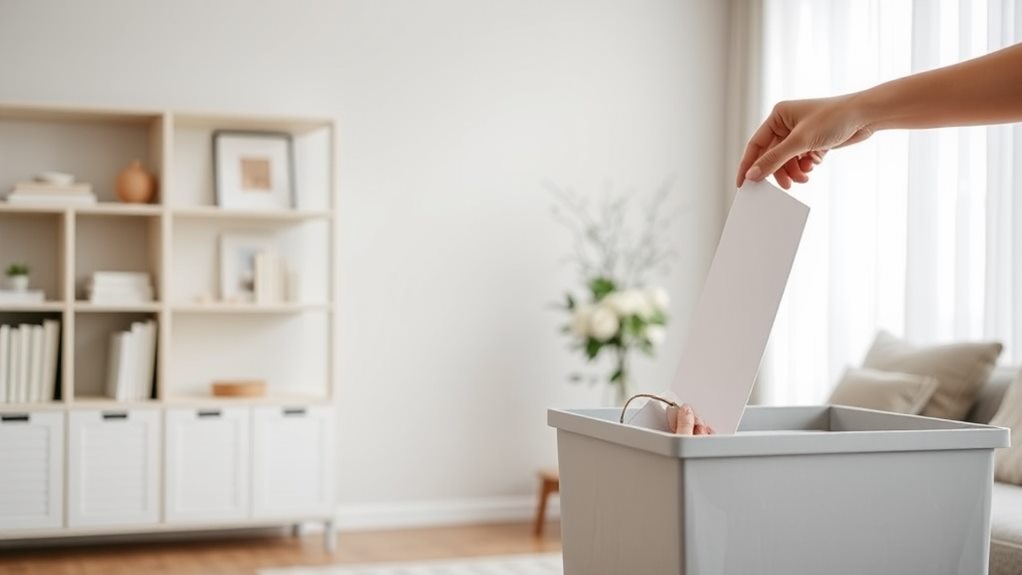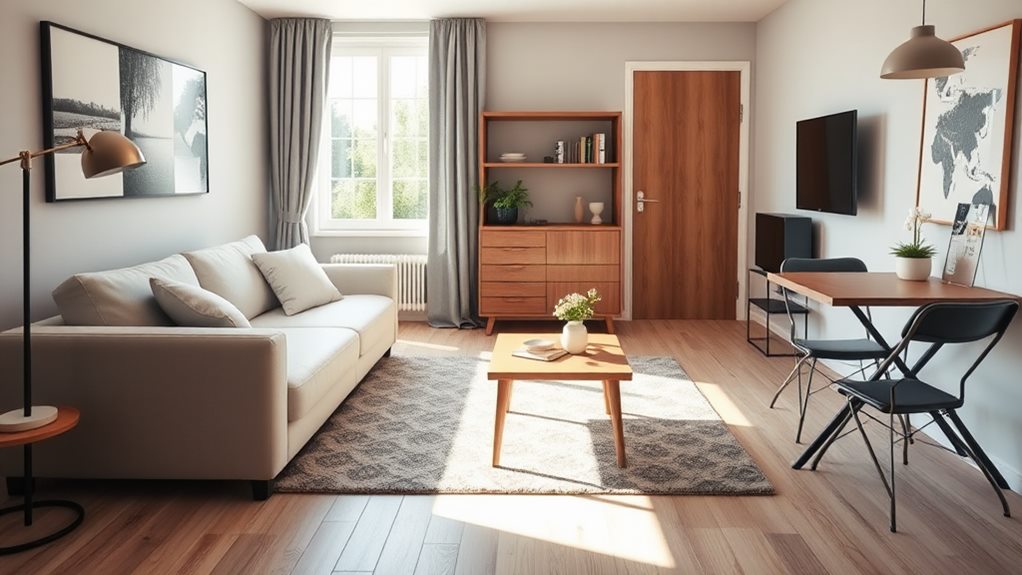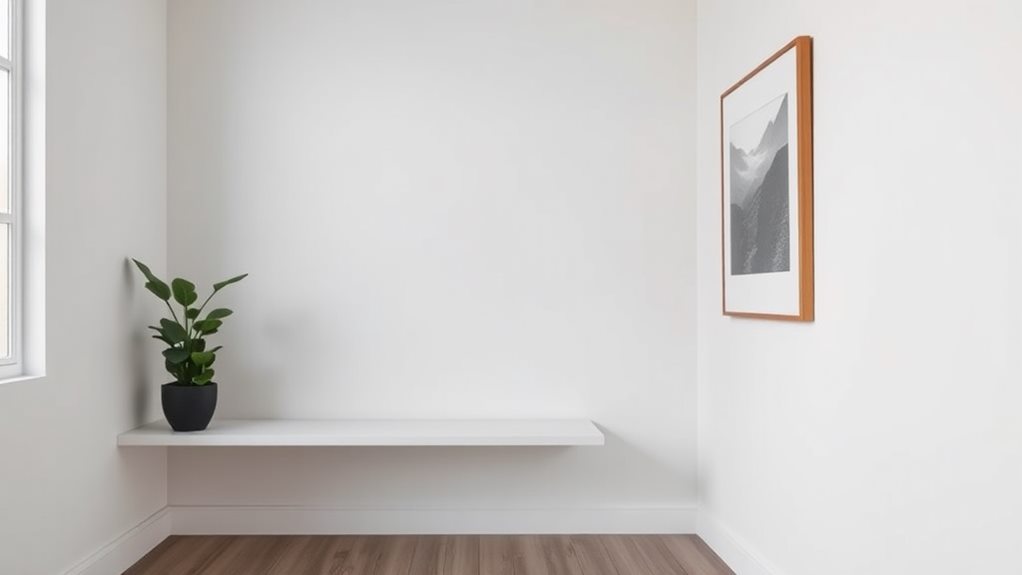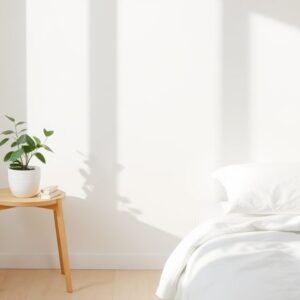Living in a small space can often feel cramped, especially when clutter starts to pile up. That's why it's important to embrace minimalist decluttering techniques. One effective strategy is the one-in, one-out rule. This means that for every new item you bring into your home, you should let go of an existing one. This practice helps you make thoughtful decisions about what you truly need while keeping your living area organized.
Vertical storage is another fantastic way to maximize your space. For instance, consider installing shelves or using tall bookcases to draw the eye upward, which can give the illusion of a larger room.
Additionally, investing in multi-functional furniture can be a game changer. For example, a coffee table that doubles as storage or a bed with drawers underneath can free up valuable floor space.
Creating a daily decluttering habit can also make a significant difference in maintaining order. Start with just 10 minutes a day to tackle a specific area, whether it's a drawer or a corner of your living room.
Over time, these small efforts add up, resulting in a serene and organized environment that feels much more spacious. By incorporating these techniques, you can transform your small space into a calm and inviting retreat.
Key Takeaways
Here are some practical tips to help you declutter and make the most of your small space:
- One-In, One-Out Rule: This simple rule is a game changer for keeping clutter at bay. Every time you bring a new item into your home, make it a habit to let go of something else. This not only helps you stay intentional about what you own but also prevents your space from becoming overwhelmed with unnecessary items. For instance, if you buy a new book, consider donating an old one to your local library or a charity shop.
- Vertical Storage: When floor space is limited, think upwards! Installing shelves or using wall-mounted racks can free up valuable space while keeping your belongings organized. For example, a tall bookshelf can store books, plants, or decorative boxes without taking up much room. This approach not only declutters but also adds visual interest to your walls.
- Multi-Functional Furniture: Look for furniture that serves more than one purpose. A sofa bed is perfect for accommodating guests without needing an extra room, and a storage ottoman can serve as both a seat and a hidden space for blankets or games. Check out options like the IKEA FÄRLÖV sofa bed or the Better Homes & Gardens storage ottoman, which combine style and functionality seamlessly.
- Daily Decluttering Routine: Set aside a few minutes each day to tidy up. Whether it's clearing off your kitchen counter or organizing a drawer, these small tasks add up over time. You could even make it a fun ritual—put on your favorite playlist and see how many items you can clear away in just five minutes. This keeps your space feeling fresh and manageable.
- Limit Decorative Items: Instead of filling every surface with knick-knacks, choose a few standout pieces that truly resonate with you. For example, a beautiful vase or an artwork you love can add character without overwhelming the space. Aim for items that not only look good but also have a purpose, like a stylish clock or a unique plant holder. This approach creates a calm atmosphere and allows your favorite pieces to shine.
By implementing these strategies, you can create a more organized and peaceful living environment, even in the smallest of spaces.
Embrace the One-In, One-Out Rule

Feeling overwhelmed by clutter in your small space? You're not alone! A great way to tackle this is by adopting the one-in, one-out rule. This simple strategy means that whenever you bring a new item into your home, you let go of an old one. By doing this, you can keep your space intentional and free from excess.
Start by really thinking about what you need. Before making a purchase, ask yourself: Does this item genuinely add value to my life? If it doesn't, it might be time to part ways. This practice not only helps you live more intentionally but also encourages you to choose purchases that reflect your values and priorities.
To make this rule work for you, set up a specific spot for items you're ready to let go of—perhaps a box or a bag for donations or items you plan to sell. As you get used to this approach, it'll become easier to resist those tempting impulse buys, helping you maintain a cleaner, clutter-free space.
Embracing the one-in, one-out rule not only makes your space simpler but also brings a sense of peace and clarity. You'll likely feel lighter and more focused, transforming your small space into a relaxing sanctuary instead of a stressor.
Plus, consider donating items to local charities or using platforms like Facebook Marketplace or Poshmark to sell them—this way, you're not just decluttering, but also giving your items a second life!
Utilize Vertical Storage Solutions
Once you embrace the one-in, one-out rule, it's time to make the most of your small space with vertical storage solutions. Wall-mounted racks can be a game-changer—they help you reclaim floor space while keeping your everyday items within easy reach.
Think about installing shelves that stretch all the way to the ceiling. This not only gives you plenty of room to organize but also draws the eye upward, making the space feel larger and more open.
When you set up your shelves, try to group similar items together. Using decorative baskets or bins can help keep things looking neat while ensuring smaller items are still easy to grab. Labeling these containers is a smart move; it saves you time and frustration when you're searching for something specific.
And don't overlook the back of your doors! Adding wall-mounted racks for shoes, accessories, or even cleaning supplies can turn what would otherwise be wasted space into practical storage.
To pull everything together, pick a color scheme that matches your decor. This simple step can make your small area feel more organized and visually appealing.
For instance, if your living space has earthy tones, consider using natural wood shelves or baskets in shades of brown and green. This thoughtful approach helps create a cohesive look that feels intentional and inviting.
Prioritize Multi-Functional Furniture

When living in a small space, choosing furniture that serves multiple functions can really improve your day-to-day life. By selecting items that do more than one job, you can make the most of your area without sacrificing usability.
For example, a sofa bed is a fantastic choice—during the day, it offers a comfy spot to relax, and at night, it easily transforms into a cozy bed for a good night's sleep.
Another smart option is an ottoman that not only provides a place to rest your feet but also has storage inside. This helps keep your space organized and clutter-free while giving you a bit of extra seating when guests come over.
Folding tables are also incredibly useful; they can expand to accommodate more people during meals and then fold up to save space when you don't need them.
Don't overlook wall-mounted desks or shelves, either. These can help you free up valuable floor space and keep everything looking neat. They're practical solutions that add to your overall decor without overwhelming your room.
By focusing on multi-functional furniture, you create a more fluid and open feel in your home. Each piece works hard to make your living area feel more spacious and welcoming.
Create a Daily Decluttering Habit
Building a daily decluttering habit can really help you maintain a clean and organized space, making it easier to enjoy a minimalist lifestyle. By incorporating small decluttering tasks into your daily routine, you'll find that keeping your environment tidy becomes second nature.
To make it even easier, here's a simple table to guide your daily decluttering efforts:
| Time of Day | Task | Duration |
|---|---|---|
| Morning Routine | Quick 5-minute tidy-up | 5 minutes |
| Midday Check-in | Assess surfaces | 5 minutes |
| Afternoon Declutter | Clear one area | 10 minutes |
| Evening Reflection | Evaluate clutter | 5 minutes |
| Weekly Review | Plan for upcoming items | 15 minutes |
In the morning, take just five minutes to tidy up your space. This could mean putting away any items that have been left out, like your coffee cup or yesterday's mail. It's a great way to start your day with a sense of accomplishment.
During your midday check-in, spend another five minutes looking around. Are there surfaces that are starting to collect items? A quick scan can help you stay on top of things before they get out of hand.
In the afternoon, dedicate ten minutes to clear a specific area—perhaps your desk or a cluttered corner in the living room. Focus on removing things that don't belong there. This intentional decluttering helps prevent overwhelm later on.
When the evening rolls around, take a moment to reflect on the clutter that may have accumulated during the day. Spend five minutes evaluating what's still lingering around. This reflection helps you stay aware of your possessions and can inform your decluttering choices moving forward.
Lastly, set aside time each week to plan for any new items that might enter your home. This could involve thinking about how to manage gifts or purchases, ensuring you keep clutter at bay. A weekly review of about 15 minutes allows you to stay proactive rather than reactive.
Limit Decorative Items and Clutter

It's easy to want to fill your home with decorative items that showcase your personality, but keeping it minimal is key to a calm and inviting space. Start by taking a good look at what you truly love—select just a few standout pieces that strike a balance without overwhelming your surroundings.
Be thoughtful about what you bring into your home. Instead of scattering lots of small trinkets across surfaces, consider using one or two larger items that can act as focal points. For instance, a striking piece of wall art or a unique sculpture can capture attention and help maintain a serene atmosphere.
Think about using decor that serves a dual purpose. A stylish woven basket, for example, can be a beautiful addition to your living room while also providing storage for blankets or magazines, helping you keep things tidy.
Remember, the goal is to have fewer items, each with a clear purpose or sentimental value.
Make it a habit to regularly check in with your decor choices. If an item no longer brings you joy or doesn't fit your minimalist aesthetic, feel free to part with it.
Frequently Asked Questions
What Are Some Benefits of Minimalist Living Beyond Decluttering?
Living a minimalist lifestyle goes beyond just getting rid of clutter in your home; it can lead to some pretty remarkable benefits. For one, it helps you make more environmentally friendly choices. By focusing on what you truly need, you're less likely to buy items that contribute to waste. For example, instead of purchasing fast fashion clothes that you might only wear a couple of times, you could invest in high-quality, sustainable pieces that last longer and have a lower impact on the planet.
Additionally, minimalism can give you a sense of financial freedom. When you stop spending money on things that don't add real value to your life, you'll find that you have more funds available for experiences that truly matter to you—like traveling, taking up a new hobby, or spending quality time with loved ones. Think about it: instead of buying the latest gadget every few months, you could save that money for a memorable trip or a course that enhances your skills.
In essence, minimalism helps you prioritize what's important, leading not only to a more organized space but also to a more fulfilling life overall.
How Can I Motivate Myself to Start Decluttering?
To get yourself motivated to start decluttering, think about the benefits you'll experience once your space is organized. Picture how nice it will feel to walk into a room that's tidy and calm. Instead of tackling everything at once, break the process down into smaller, easier tasks. For instance, you could set a goal to declutter just one drawer or a specific corner of a room each day. This way, it feels less overwhelming. When you complete each task, take a moment to celebrate your progress—maybe treat yourself to a favorite snack or enjoy a relaxing break.
What Are Some Common Mistakes in Minimalist Decluttering?
One common mistake people make while decluttering is holding onto too many items, often because they believe they need everything they own. This can stem from emotional attachments to certain belongings, making it challenging to part with them. It's important to take a step back and assess the true value of each item. Ask yourself questions like, "Does this item improve my life or bring me joy?" or "When was the last time I used this?" By evaluating each piece for its actual impact on your space and lifestyle, you can make more informed decisions about what to keep and what to let go. For instance, if you have ten coffee mugs but only use your favorite one daily, consider donating or recycling the rest. This strategic approach not only simplifies your environment but also helps you focus on what truly matters to you.
How Do I Maintain a Minimalist Lifestyle Long-Term?
To keep a minimalist lifestyle for the long haul, it's essential to build habits that stick and make choices that matter. Start by regularly reviewing what you own. Ask yourself if each item enhances your life or just takes up space. For example, instead of having a bunch of cheap kitchen gadgets, invest in a high-quality chef's knife that will last for years and make cooking a pleasure. This shift to valuing quality over quantity can significantly simplify your life.
Also, think carefully about your purchases. Before buying something new, consider whether it will genuinely add value to your daily routine. This might mean waiting a few days before making a decision, which can help prevent impulse buys. By maintaining this intentional mindset, you'll find that your living space becomes more organized and peaceful, allowing you to focus on what truly matters to you.
Can Minimalist Decluttering Improve Mental Health?
Absolutely! Minimalist decluttering can have a positive impact on your mental health. When you start to simplify your surroundings, it's like clearing away the mental fog that often clouds your thoughts. By embracing a more mindful approach to the items you keep, you're not just tidying up your space; you're also creating emotional freedom. This can lead to a significant reduction in stress and anxiety levels.
Think about it: when your space is clutter-free, it's easier to concentrate on what truly matters to you. For example, if you have a clean desk, you're more likely to focus on your work or hobbies without the distractions of unnecessary items. Plus, a minimalist environment can inspire a sense of peace and clarity in your life, allowing you to prioritize your well-being.
If you're looking to dive into decluttering, consider starting with a specific area, like your bedroom or workspace. You might find it helpful to use storage solutions like clear bins or drawer organizers to keep essential items visible yet contained. This way, you create a serene space that reflects your values and priorities, ultimately fostering a healthier mindset.
Conclusion
If you want to make the most of your small space, these decluttering tips can really help you create a functional and inviting home. One great strategy is the one-in, one-out rule. This means that whenever you bring something new into your home, you should let go of something old. This simple habit prevents clutter from piling up and keeps your space manageable.
Another effective approach is utilizing vertical storage. Think about installing shelves that reach up to the ceiling or using hooks for bags and hats. This way, you can free up floor space and keep your essentials accessible. Multi-functional furniture is also a game changer. For example, consider a coffee table that doubles as a storage chest or a sofa bed for guests. This versatility gives you more room to breathe without sacrificing comfort.
Making decluttering a daily habit can be very beneficial. Set aside just 10 minutes each day to tidy up. You'll be surprised at how much of a difference that small time investment can make over the week. Lastly, when it comes to decorations, less is often more. Choose a few meaningful pieces that really resonate with you rather than overcrowding surfaces. This not only creates a more serene atmosphere but also allows the items you do display to shine.
By following these practical tips, you'll find that your home feels more organized and spacious, perfectly reflecting a minimalist lifestyle that prioritizes simplicity and functionality.







